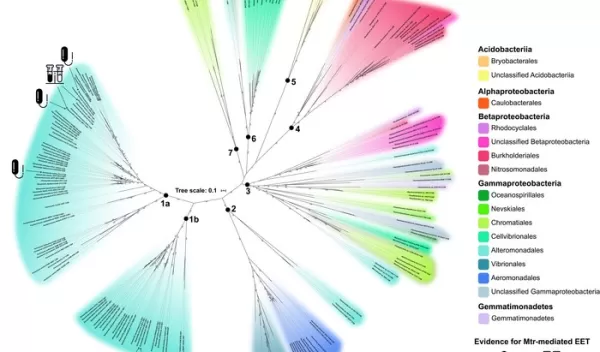
Global genome search sparks new insights into microbes that breathe rocks
Microbes may be miniscule, but they have a massive impact on Earth and its habitability. They are different than animals, plants and other eukaryotic organisms in that they can gain energy from "breathing" a surprisingly wide range of surfaces and materials, including rocks.
Microbes also drastically reshape their environment as they feast on these energy sources, making microbes major players in the cycling and availability of nutrients on Earth. One well-known example is the rise of oxygen on Earth due to the metabolism of photosynthetic cyanobacteria.
In recent years, scientists have discovered a new process by which microbes can "breathe" rocks through a process called extracellular electron transfer, or EET, a form of respiration. With EET, microbes are able to generate energy from rocks and other materials that are outside their cells.
Microbes establish an electrical connection to the outside world, a connection they use to generate the power they need to grow. Researchers have since found ground-breaking uses for EET-capable microbes, such as aiding toxic waste cleanup and serving as a source of alternative energy.
In a U.S. National Science Foundation-funded study published in mBio, researchers at Harvard University and the University of Minnesota surveyed the tree of life in search of EET and discovered that it's far more widespread than previously thought.
"Global microbial genome sequences continue to be a goldmine for revealing new aspects of Earth's biodiversity," said Matt Kane, a program director in NSF's Division of Environmental Biology.
One set of genes that makes EET possible, called mtrCAB, has been well-studied in the bacterium Shewanella oneidensis. Shewanella oneidensis was among the first EET-capable organisms discovered.
"A lot of our understanding of mtrCAB comes from studies in this particular organism," said co-lead author Isabel Baker of Harvard University. "But we don't really know how widespread this type of metabolism is among life's branches. Understanding that will help us pinpoint where this metabolism is at play in global biogeochemical cycles."
Baker and co-senior author Peter Girguis of Harvard collaborated with University of Minnesota researchers Jeffrey Gralnick and Bridget Conley. The scientists found that the genes exist in more organisms than previously assumed, and in environments all over the world. "All the organisms we identified are capable of plugging directly into the substrates in their environment and changing what's available there," said Girguis.


